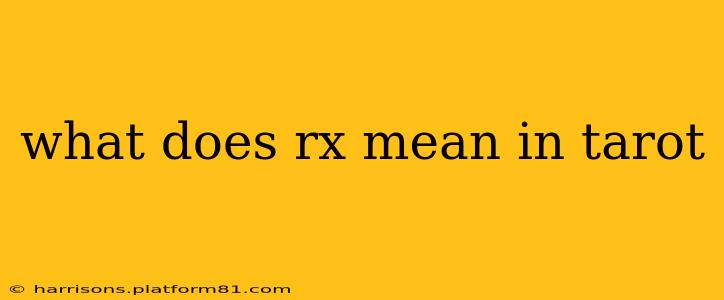The world of tarot can be captivating and mysterious, filled with symbolism and potential interpretations. One common point of confusion, especially for beginners, is the meaning of "RX" in a tarot reading. Simply put, RX stands for reversed. It signifies that a particular card in your spread appears upside down. But what does this actually mean? Let's delve into the intricacies of reversed cards and how to interpret them.
What Does a Reversed Card Indicate?
The interpretation of reversed cards is a subject of ongoing debate within the tarot community. Some readers choose not to use reversed cards at all, preferring to focus solely on the upright meanings. Others believe that reversed cards offer a valuable layer of nuance and complexity to the reading.
Generally, a reversed card isn't necessarily negative, but rather suggests a shadow aspect or a modification of the upright meaning. Think of it as highlighting potential challenges, blockages, or internal struggles related to the card's core theme. It might indicate a delay, an inner conflict, or a need for introspection.
Common Interpretations of Reversed Cards
While the specific meaning will vary depending on the card itself, here are some common ways reversed cards are interpreted:
- Internal struggle or shadow self: The reversed card might point to repressed emotions, negative patterns of behavior, or unresolved inner conflicts related to the card's theme.
- Obstacles and delays: Reversed cards can indicate challenges or setbacks along the path, suggesting delays or obstacles that need to be overcome.
- Lack of balance or integration: The card's energy might be unbalanced or out of alignment in the querent's life.
- Potential for growth: Interestingly, some see reversed cards as opportunities for growth and self-discovery. By acknowledging the shadow aspect, you can work towards greater self-awareness and positive change.
How to Interpret Reversed Cards in Your Readings
There's no single "right" way to interpret reversed cards. Here's a suggested approach:
- Understand the upright meaning: Before interpreting a reversed card, thoroughly grasp the upright meaning of the card. This forms the foundation for understanding its reversed counterpart.
- Consider the context: The surrounding cards in your spread provide crucial context. How does the reversed card interact with the other cards? This interplay can offer deeper insights.
- Intuition: Trust your intuition. Sometimes, the reversed card might simply feel "off" or suggest a different angle compared to its upright meaning. Don't be afraid to follow your gut feeling.
- Focus on the shadow aspects: Look for the less positive or challenging aspects of the card's meaning. What are the potential pitfalls or obstacles associated with this card's energy?
- Seek the lesson: Even challenging reversed cards often offer valuable lessons and opportunities for growth. What can you learn from the situation represented by the reversed card?
Are Reversed Cards Always Negative?
No! Reversed cards are not inherently negative. They simply offer a different perspective on the card's energy, highlighting potential challenges or areas needing attention. They can signal opportunities for growth, self-reflection, and overcoming obstacles. The interpretation depends greatly on the card itself and the context of the entire reading.
Do All Tarot Readers Use Reversed Cards?
No, not all tarot readers use reversed cards. Some readers prefer to focus only on the upright meanings, finding them sufficient for accurate readings. The choice of whether or not to use reversed cards is entirely personal and depends on the reader's approach and style.
Why is there so much debate about reversed cards?
The debate stems from the varied interpretations and traditions within the tarot community. Some see reversed cards as adding important nuances, while others feel they introduce unnecessary complexity. Ultimately, the method used should align with the reader's intuition and style.
By understanding the nuanced approach to interpreting reversed cards, you can deepen your understanding of tarot and gain more insightful readings. Remember, the journey of tarot interpretation is personal, and finding your own method is key to unlocking its potential.
